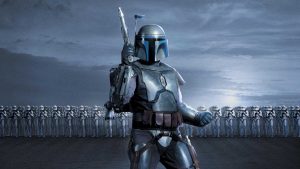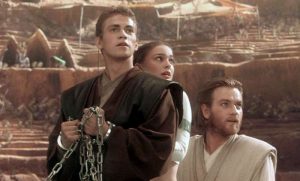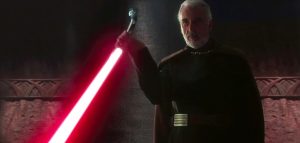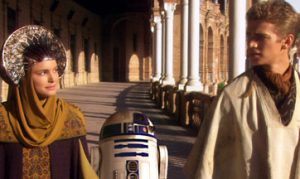We are officially in the last leg of the long journey to Star Wars: The Rise Of Skywalker, which means that the mighty Skywalker Saga, a story spanning forty years across films, books, comics, cartoons and video games is finally coming to a close – which in turn means that it’s time to reflect on that nine-part saga and take a good long look at the films that predate and inform Rise Of Skywalker‘s epic conclusion.
To do that, we’re going to have to discuss spoilers for each of the eight films in the Saga, so…SPOILERS AHEAD.
Star Wars: Revenge Of The Sith
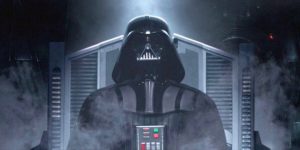
Despite being the continuation of George Lucas’ underwhelming prequel trilogy (and the last Star Wars film he’s directed), Revenge Of The Sith is not a fitting conclusion to this chapter in the Skywalker Saga. Why do I say that? Because, while it may be sacrilegious to some, I feel strongly that Sith is miles ahead of both its predecessors, and deserves far more praise than it has gotten (to be fair, its Rotten Tomatoes score is actually pretty good).
There are several things that make Sith the best movie in the prequel trilogy and a good movie regardless. The story has a singular focus on Anakin Skywalker (Hayden Christensen), and all the other subplots, from the Clone Wars to the Trade Federation, finally find a way to tie into his story without Lucas having to force him into theirs. The themes are stronger than before, with Lucas finally plunging bravely into Anakin’s darkness – it’s too late to understand him or sympathize with his journey, but we’re no longer called upon to do so: instead, Lucas merely asks us to marvel at the horror and spectacle of it all. And isn’t that what moviegoers do best? And there are several scenes, characters and plot-points here that are among the strongest in the entire franchise.
The first and least surprising of many revelations is Ian McDiarmid as Chancellor Palpatine a.k.a Darth Sidious. While Phantom Menace and Clones wasted the actor’s talents on rambling monologues about trade reform and taxation, he was gifted some of the trilogy’s best dialogue in Sith – where he also finally gets to shed his disguise and become the horrible, cackling, wild-eyed goblin we all know and love. In the scenes immediately preceding his grotesque transformation, where he slowly but surely seduces Anakin over to the Dark Side of the Force, McDiarmid is at his finest: a silver-tongued charlatan selling the promise of immortality with ease, grace and dignity. As the film’s title suggests, the power of the Sith has grown unstoppable: despite there only ever being two Sith Lords at a time, their ability to manipulate is their greatest weapon, as we learn that Palpatine has been using lies and deception to grow stronger in the Senate, until he finally takes the mantle of Emperor, and begins his reign of terror. And he has help from all over the galaxy, even briefly from Count Dooku (Christopher Lee) who fails him early in the film and is executed by Anakin, and the legendary General Grievous (voiced by Matthew Wood), a lightsaber-wielding quadrupedal cyborg with a nasty cough, who lurches his way through a series of epic battles. And the Emperor’s most secret weapon, and the one which ultimately gives him the advantage over his age-old enemy, is Order 66.
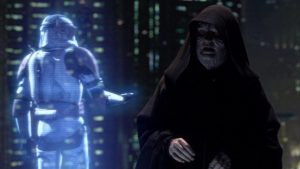
It’s one of those scenes that screams “instant classic”. Though we had heard of the Purge that wiped out thousands of Jedi across the galaxy, seeing it was something else entirely: John Williams’ haunting music, the beautiful imagery, and the sheer nightmare of watching vast clone armies turn against their commanders at the push of a button. Honestly, it’s even more painful to watch than the Battle of Helm’s Deep in The Lord Of The Rings, where the Elves of Lórien are brutally slaughtered in battle, because of how quickly and easily this massacre is carried out: from Plo Koon’s violent death, blown to pieces in the explosion of his spacecraft, to Aayla Secura gunned down before she could even comprehend the click of loaded blaster-guns behind her, her body tumbling peacefully into a field of giant flowers. Only a handful of Jedi escape the purge, whether through their own quick-thinking – as in the case of Yoda (voiced by Frank Oz) – or because of a very helpful accident, as with Obi-Wan Kenobi (Ewan McGregor).
But despite how sad we all are about the Jedi Purge (or maybe because of it), we can’t help but love every second of Anakin Skywalker’s long, slow, agonizingly painful transformation from man to machine. Not only is it great to see him bested in battle by Obi-Wan Kenobi and left for dead, a burning husk of a ruined man, on the lava shores of Mustafar, but it’s fantastic to watch what happens next, as this man-thing is brought back from death’s brink, stitched together by the Emperor’s medics and minions, clothed in darkness and wreathed in horror – and also blessed with the rich, powerful voice of James Earl Jones.

Anakin’s meandering journey through two previous movies left aside, Sith finally gives us what we were looking for from this character: an actual explanation for why he turned to the darkness, one that is every bit as dark, horrific and irredeemable as it needed to be. In this final movie, George Lucas works overtime to come up with a good reason for his hero’s sudden shift in loyalties, and he comes up with something that, while not startlingly original, at least feels legitimate, given what we know already about Anakin’s character, and the lengths he will go to to protect those that he loves. The explanation is simply this: Anakin, in his desperate need to save the life of his wife Padmé (Natalie Portman), ends up being lured to the Dark Side to explore the promise of immortality, a promise which he learns too late is nothing but a lie. Yes, stronger chemistry between Portman and Christensen would have gone a long way in selling this idea, and the prequel trilogy in general, but I can hardly fault the actors for not being able to conjure up much genuine emotion, considering the poorly underwritten dialogue. But at least it’s something – and Lucas, for what feels like the first time in this trilogy, understands that Anakin is a villain at his core. Rather than try to make him sympathetic or understandable, Lucas shows us just how irrational and horrible he is, even falling back on the Anakin-murders-innocent-children trope from the last movie, but this time without having anybody come up with stupid, clumsy excuses for why he did what he did. He’s not a good person: he never was. The evil spirit of Darth Vader always lived inside Anakin – it just needed to be coaxed out by the Emperor’s cunning words. I don’t even think that Anakin being a truly evil person makes his “redemption” and sacrifice in Return Of The Jedi unearned: as I wrote in my review of that film, I feel Vader’s choice to betray the Emperor was his attempt to do right by Padmé, who I think he truly loved. In Return Of The Jedi, he was motivated exclusively by his desire to save the life of his own children, not by any concern for the Rebellion, or the Jedi. He was a selfish and overly protective person until the day he died: was there light in him, as Luke claimed? I believe there was, but it expressed itself in his love for a woman whose death he had caused, and whose children he had tormented.
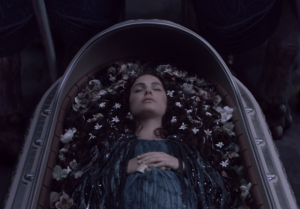
Speaking of that particular woman’s death, however, we do have to address the biggest issue in Revenge Of The Sith: Padmé being fridged, or to be precise, pre-fridged. “Fridging”, a term which refers to a female character being killed or harmed to further a male character’s storyline, is not strictly applicable in this case, because it wasn’t Padmé’s death, but rather the fear of her death, that motivated Anakin to madness. But regardless of what happened when, Padmé is barely even a character in this movie, having little more to do than act as Anakin’s muse and the mother of his children. She makes one powerful decision near the end of the movie, when she chooses to leave her husband for good – but even afterwards, she’s still haunted by him. How she dies is something of a mystery: her doctor droid says something about her losing the will to live, but the clever juxtaposition of her death with Anakin’s painful resurrection, combined with Palpatine’s remark to Anakin that “it seems, in your anger…you killed her”, almost implies that it was Anakin’s grief and the burning fires of his anguish that somehow drained her of her stamina. A semi-telepathic link between the two is possibly teased earlier in the film, when Anakin and Padmé seem to “see” each other from opposite sides of the city of Coruscant, or at least can feel the other’s presence very strongly. While it’s not explained if this is the case, it makes more sense than the resilient Padmé Amidala dying of sorrow.
Another interesting fact about Padmé’s death, mere moments after both her children are born into the fluorescent light of the Polis Massa maternity ward: Leia is born just after her twin brother Luke, almost seeming to underscore her birth as the more notable of the two. Given everything we know about Leia’s character arc, it wouldn’t be entirely implausible to believe that this was yet another hint that Leia Organa was destined to be the true heroine of the Skywalker Saga. Just a thought.

Finally, we have to talk about the film’s action sequences, which range from “meh” to “magnificent”. There are two in particular that stand out to me: the battle on Utapau that pits Obi-Wan Kenobi against Grievous, who, as previously mentioned, wields four lightsabers at once, with metal arms spinning and swirling like helicopter-blades as he uses all of Count Dooku’s fighting techniques. Kenobi has never been the franchise’s most skilled dueler, preferring brute force tactics, which makes the fight a little unbalanced until he wrenches open the cyborg’s chest cavity and puts a few laser-bolts into his heart – I’m not precisely sure on the mechanics of why Grievous promptly goes up in flames, with fire erupting from his eye-sockets, but it’s a cool visual. And then, of course, there’s a much bigger, more epic battle in which Yoda and Emperor Palpatine chase each other through the cavernous Senate Building, employing force lightning and insanely fast-paced lightsaber action. It’s Palpatine’s best moment in the series’ history, and McDiarmid (not to mention his CGI stand-in) nails it. After that high, the final battle between Skywalker and Kenobi on Mustafar is bound to be disappointing, not least of all because the CGI lava is spectacularly unconvincing.
So Revenge Of The Sith is not only a return to form for the franchise, but a fun, thrilling, and tragic conclusion to a trilogy that could so easily have ended with a resounding thud. It’s cool to witness Anakin’s ruinous downfall in real-time, as the whiny teen becomes the impressive Sith Lord we were all just waiting to see. It’s satisfying to be present at Luke and Leia’s birth, and see them brought to their new homes on Tatooine and Alderaan, respectively. It’s nice to be able to have seen this chapter of Star Wars history, even if it wasn’t always great, or good, for that matter. And it’s also nice to close out this chapter with a film that, for all the flaws it’s burdened with by two prior failures, somehow manages to tell a decent story about light, darkness, and the enduring nature of hope.
Movie Rating: 7.9/10
